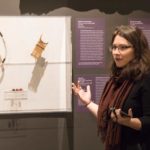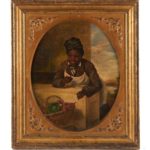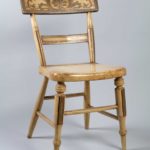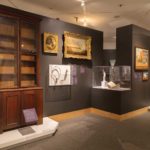Building New Connections in Baltimore
EMERGING SCHOLARS > CURATORIAL INTERNSHIP GRANTS
Elisabeth Mallin,
The Decorative Arts Trust Associate Curator, Maryland Historical Society
I joined the staff at Maryland Historical Society (MdHS) in March for a two-year appointment sponsored by the Decorative Arts Trust with the assistance of the Marie and John Zimmermann Fund. I was hired primarily to analyze the furniture collection but quickly learned that my responsibilities in an institution with only four museum staff would propel me into every facet of the collection and museum. My first task was to help prepare and dress twenty costume forms for a pop-up fashion exhibit at an off-site fundraising gala. By the end of the first month I was fielding all donation offers and preparing accession and deaccession paperwork for review by our Museum Committee and Board of Trustees.
As a graduate of the Winterthur Program in American Material Culture and through past positions as an Andrew W. Mellon and Marshall Steel Sr. Fellow at Colonial Williamsburg, I was prepared for this variety of tasks. The guidance and mentorship of Alexandra Deutsch, Director of Collections and Interpretation at MdHS, however, has proven to be my most essential asset. This was particularly true as we embarked on the exhibition Structure & Perspective: David Brewster Explores Maryland’s Social Landscape (Fig. 1). The project began several years prior to my arrival at MdHS when the museum initiated a collaboration with Brewster, a Maryland-born artist who was commissioned to render a series of paintings on contemporary themes including race, gender, politics, and the changing landscape of Maryland’s urban and suburban environments (Fig. 3). When I arrived at MdHS, Alexandra was creating the framework through which Brewster’s paintings would be juxtaposed against objects from the museum and library’s collections. These comparisons illustrated how historic objects and issues can resonate and inform today’s social and political discourse.
I jumped into the tasks required for an exhibition that includes 70 paintings loaned from the artist and private collections, as well as over 50 historic objects from our collection. We created an evolving object list, executed loan paperwork for almost a dozen lenders, and commenced the monumental task of researching the items from MdHS’ holdings, many of which had never been displayed before. Drawing on my prior experience as an editorial research fellow at Yale University, I took on the assignment of editing the exhibit catalog. Alexandra and I coauthored the 120-plus object labels. Alexandra’s mentorship during this process was invaluable. As an experienced curator and scholar, she is a wonderful combination of teacher and leader, offering guidance while trusting me with the responsibility and control to act independently. Her confidence has directly contributed to my professional development in this role.
Investigating selections for the exhibit offered a wonderful opportunity to explore MdHS’s collections, unearth material in storage, and establish new connections between disparate objects (Fig. 7). The most important link I uncovered is between a painted side chair, a rare example of early Baltimore fancy furniture owned by an African-American family (Fig. 5), and a landscape painting of Perry Hall by Francis Guy (Figure 2). The chair’s original owner, Ester Hall, was enslaved to Harry Dorsey Gough, the owner of Perry Hall. Guy’s painting features enslaved workers and indentured servants at work in the fields, with the slave quarters in the distance. After making this connection, I also discovered that Gough gave the painting to Esther Hall, who may have been his daughter, and who ultimately manumitted Hall and her children, albeit not until their 25th birthdays after they had already provided many years of productive labor.
Pulling together the histories of Esther Hall’s descendants, I was struck by their impact on Baltimore’s African-American Community and determined we could continue to tell their stories through other objects in our collection. Esther’s grandchildren were born free in the 1840s and 1850s. Coincidentally, MdHS recently acquired at auction a rare and powerful portrait of a free African-American fruit vendor by Andrew John Henry Way, circa 1860 (Fig. 4). The sitter is anonymous, but we felt the portrait was an important representation of 19th-century Baltimore’s sizable free black population, the largest in the nation. Contrasted against the narrative of Esther’s family, the painting serves as an extraordinary interpretive object, giving a face to an often-invisible history.
Following the Civil War, one of Esther’s great-grandsons became an African Methodist Episcopal minister in Maryland. AME churches served as centers of community engagement and opportunity for African Americans, who lacked access to public schools and other resources. The Structure & Perspective exhibition addressed this topic through a painting by the important African-American folk artist Alphonso Willums, who depicted an AME church on the Eastern Shore during a 1930s Fourth of July Celebration (Fig. 6). We now had a wonderful opportunity to expand the interpretive reach of Willums’ picture by connecting it to Esther Hall’s family and a matrix of objects that tell a broad story about the African-American experience in Maryland.
To bring these stories into the present, we connected artifacts from the Maryland Colonization Society (an organization that sought to send freed slaves to settle a colony in what is now the Republic of Liberia in West Africa) with David Brewster’s paintings based on images from the Preserve the Baltimore Uprising photograph archive. This repository of digital images was established at MdHS after the death of Freddie Gray in 2015. The exhibit thereby illustrates Maryland’s long history of racial inequality, the failed attempts to remediate it, and the challenges that African Americans still contend with to this day. By actively engaging with these themes, MdHS hopes to illustrate the impact that a history museum can have in contemporary society.
I look forward to continuing my research into the collections at MdHS and to gain additional experience in exhibitions, publications, and collection management. I am grateful to the Decorative Arts Trust and the Marie and John Zimmermann Fund for creating this opportunity by partnering with an innovative and proactive institution like MdHS. The ambitious scope of our endeavors, despite the small museum staff, ensures that I am playing a truly essential role in every aspect of the curatorial field during my internship!







